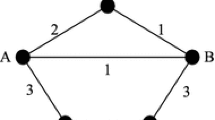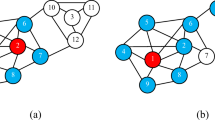Abstract
Opinion leaders in online social networks are important for various fields such as public opinion propagation, marketing management, administrative science and even politics. There are often many kinds of relationships in an online social network. Detecting and identifying opinion leaders depending on any one kind of relationship is inaccurate. In this paper, node importance analysis in multi-relationship online social networks was proposed by signalling based on Multi-subnet Composited Complex Networks Model, and considering the characteristics of multiple relationships which would interrelate with each other. Through node importance under multiple relationships, the novel opinion leader detecting algorithm in multi-relationship online social networks is proposed and approved to be efficient by experiments described in this paper.







Similar content being viewed by others
References
Belz FM, Baumbach W (2010) Netnography as a method of lead user identification. Creat Innov Manag 19(3):304–313
Bilgram V, Brem A, Voigt KI (2008) User-centric innovations in new product development—systematic identification of lead users harnessing interactive and collaborative online-tools. Int J Innov Manag 12(03):419–458
Callaway D, Newman J, Strogatz S (2000) Network robustness and fragility: percolation on random graphs. Phys Rev Lett 85:5468–5471
Ding, C., He, X., Husbands, P., Zha, H., and Simon, H. D. PageRank, HITS and a unified framework for link analysis. In Proceedings of the 25th annual international ACM SIGIR conference on Research and development in information retrieval, 2002, pp. 353–354
Freeman L (1977) A set of measures of centrality based on betweenness. Sociometry 40(1):35–41
Haibo H, Xiaofan W (2008) Analysis of online social networks based on complex network theory. Complex Syst Complexity Sci 2(5):1–14
Huang B, Yu G and Karimi H R. The finding and dynamic detection of opinion leaders in social network. Probl Eng 2014
Kim H, Tang J, Aderson R (2012) Centrality prediction in dynamic human contact networks. Comput Netw 56(3):983–996
Kratzer J, Lettl C (2009) Distinctive roles of lead users and opinion leaders in the social networks of schoolchildren. J Consum Res 36(4):646–659
Lazarsfeld PF, Berelson B, Gaudet H (1965) The people’s choice. How the voter makes up his mind in a presidential campaign. Columbia University Press, New York
Mazhari S, Fakhrahmad SM, Sadeghbeygi H (2015) A user-profile-based friendship recommendation solution in social networks. J Inf Sci 41(3):284–295
Milgram S (1967) The small world problem. Psychology today 2(1):60–67
Miller, J. C., Rae, G., Schaefer, F., Ward, L. A., LoFaro, T., and Farahat, A. Modifications of Kleinberg's HITS algorithm using matrix exponentiation and web log records. In Proceedings of the 24th annual international ACM SIGIR conference on Research and development in information retrieval, 2001, pp. 444–445
Okamoto K, Chen W, Li X (2005) Ranking of closeness centrality for large-scale social networks. Lect Notes Comput Sci 59:186–195
Opsahl T, Agneessens F, Skvoretz J (2011) Node centrality in weighted networks: generalizing degree and shortest paths. Soc Networks 32(1):245–251
Qingqing Z (2013) Relationship between scores and tags for Chinese books-in the case of Douban book. Chinese J Libr Inf Sci 6(4):40–54
Ravi K, Ravi VA (2015) Survey on opinion mining and sentiment analysis: tasks, approaches and applications. Knowl-Based Syst 89:14–46
Severyn A, Moschitti A, Uryupina O (2015) Multi-lingual opinion mining on YouTube. Inf Process Manag 52(1):46–60
Song, X, Chi, Y, Hino, K, and Tseng, B. Identifying opinion leaders in the blogosphere. In Proceedings of the sixteenth ACM conference on Conference on information and knowledge management, 2007, pp. 971–974
Song X, Yan X, Li Y (2015) Modelling liking networks in an online healthcare community: an exponential random graph model analysis approach. J Inf Sci 41(1):89–96
Von Hippel E (1986) Lead users: a source of novel product concepts. Manag Sci 32(7):791–805
Von Hippel E (2007) The sources of innovation. Das Summa Summarum des Management. Gabler, p 111–120
Xia Y and Fan J. Efficient attack strategy to communication networks with partial degree information. 2011 I.E. Int Symp, 2011, pp.1091–1095
Yu X, Wei X, Lin X (2010) Algorithms of BBS opinion leader mining based on sentiment analysis. Web Information Systems and Mining. Springer Berlin Heidelberg, Heidelberg, pp 360–369
Zhai Z, Xu H, Jia P (2008) Identifying opinion leaders in BBS. Web Intelligence Intell Agent Technol:398–401
Acknowledgements
Many thanks are due to Neal Gilmore and Karen Gilmore for their assistance in language revision. Also, thanks to the editor and all anonymous reviewers for their constructive comments.
Funding
This work is supported by the Humanity and Social Science Youth foundation of Ministry of Education of China (grant no. 15YJC860001). This research is also supported by the Social Science Foundation of Qingdao, China (grant no. QDSKL150437), Statistical Science Research Project of China (grant no. 2015LZ20) and China Postdoctoral Science Foundation Funded Project (grant no. 2015 M580571, grant no. 2016 M590612).
Author information
Authors and Affiliations
Corresponding author
Rights and permissions
About this article
Cite this article
Sun, G., Bin, S. A new opinion leaders detecting algorithm in multi-relationship online social networks. Multimed Tools Appl 77, 4295–4307 (2018). https://doi.org/10.1007/s11042-017-4766-y
Received:
Revised:
Accepted:
Published:
Issue Date:
DOI: https://doi.org/10.1007/s11042-017-4766-y




